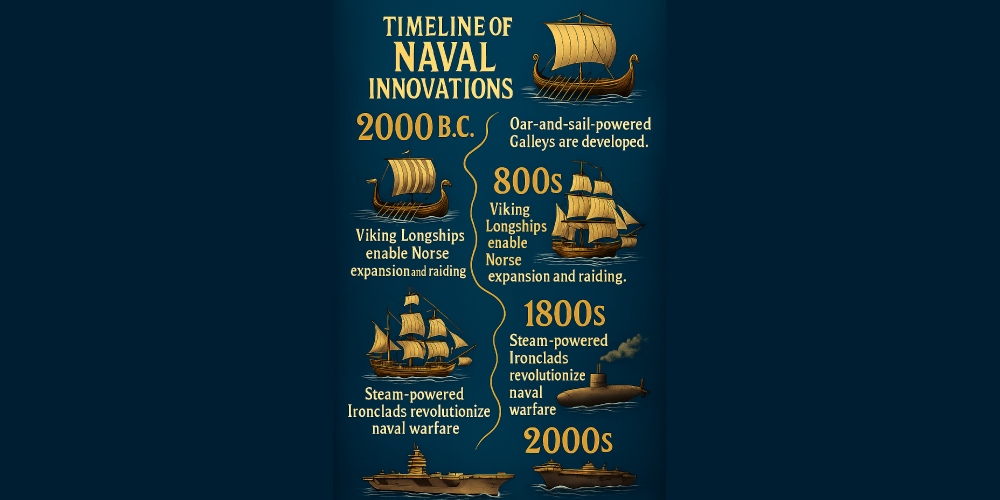
From Ancient Ships to Modern Naval Supremacy
Naval history is the story of how humans have mastered the seas through technological innovation. This timeline highlights the most significant maritime advancements, from ancient oared warships to today’s autonomous vessels. Each innovation has not only shaped naval warfare and trade but has also played a pivotal role in the rise and fall of empires.
c. 2500 BC – Trireme: War at Sea Begins
Used by ancient Mediterranean powers, the trireme was a swift and agile warship powered by three rows of oars. It revolutionized naval combat through coordinated rowing and ramming tactics.
c. 800 AD – Viking Longships
The Vikings developed longships capable of both ocean voyages and river navigation. Their speed and shallow draft allowed for surprise raids and exploration across Europe and even into North America.
15th Century – The Caravel: Engine of Exploration
Portuguese and Spanish explorers used caravels—highly maneuverable sailing ships—to reach new continents. They were the backbone of the Age of Discovery, enabling long-range trade and colonization.
17th Century – Ship of the Line
The rise of the “line of battle” tactic led to the construction of heavily armed warships designed to fight in formation. Naval battles became strategic, coordinated affairs involving massive firepower.
19th Century – Ironclads
Steam-powered, iron-armored ships like the HMS Warrior and USS Monitor marked the end of wooden warships. These ironclads ushered in industrial-age warfare at sea.
1860s – Torpedo Boats
Small, fast vessels equipped with self-propelled torpedoes emerged as a low-cost threat to large warships. Their stealth and speed changed naval tactics, especially in coastal waters.
1906 – HMS Dreadnought
This British battleship introduced the “all big gun” design and steam turbine propulsion. It rendered previous battleships obsolete and set the standard for 20th-century naval power.
1950s – Nuclear Submarines
Powered by nuclear reactors, submarines like the USS Nautilus could remain submerged for months. This advancement transformed naval strategy, especially during the Cold War.
1970s – Aircraft Carriers as Floating Airbases
Modern carriers became mobile power projection platforms, capable of launching airstrikes anywhere in the world. They symbolized geopolitical reach and deterrence.
1990s – Smart Missile Systems & Digital Navigation
The integration of GPS, radar, and guided missile systems allowed ships to operate with unprecedented precision and autonomy. Warfare at sea became increasingly digitized.
2000s–Present – Autonomous Naval Systems
The newest innovations include unmanned surface and underwater vehicles (USVs and UUVs) used for reconnaissance, mine-clearing, and even combat. AI integration is reshaping the future of naval operations.
Conclusion: A Legacy of Innovation at Sea
Naval innovations have continually reshaped history—not just through war, but by enabling exploration, colonization, and cultural exchange. As technology advances, so too does humanity’s mastery over the oceans. From ancient triremes to AI-powered drone ships, the timeline of naval progress tells the story of civilization itself.